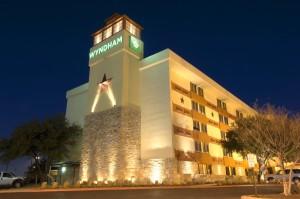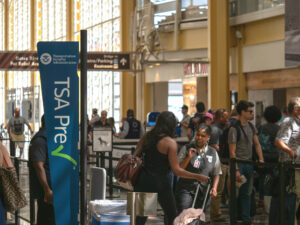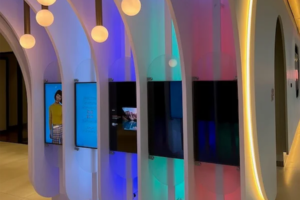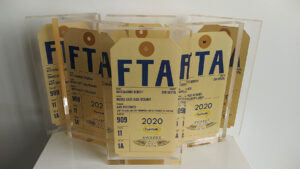Last edit by: philemer
Posts from 1/1/16 onward can be found here: http://www.flyertalk.com/forum/credit-card-programs/1739359-2016-onward-usa-emv-cards-availability-q-chip-pin-signature.html
EMV wikipost volunteers: kebosabi
What is EMV?
EMV is a defacto global standard of technology where there is a visible microchip on the front of the card. It looks like this:
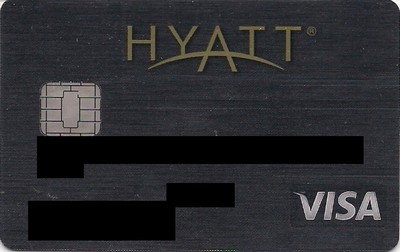
Who issues them?
See Google Docs spreadsheet in Post #1
SFOAMS also has created a list of excellent webpage that shows US EMV cards in a more interactive interface
Another site, which lets you narrow the search for an EMV card by various parameters, is http://www.spotterswiki.com/emv/index.php.
Several credit unions issue some form of Chip-and-PIN credit cards or prepaid cards. Prepaid EMV cards however are not recommended due to junk fees. USAA (currently restricted to members of military) used to offer Chip-and-PIN cards, but as late has backtracked to Chip-and-Signature priority.
Hey that's a cool Google Docs list! I know others that aren't on that list. How can I help by adding them to the list?
My bad for not putting this into the wiki sooner. Right now, the Google Docs is locked out of editing and only in "read-only" view because there were instances in the past where people would just delete the rows not thinking that it affects others viewing the list.
If you promise not to delete any rows and input all the pertinent info (annual fee, rewards, FTF, etc.), I can provide you with edit access. Just shoot me a PM to kebosabi with your gmail address and I'll provide you edit access.
Thanks for helping out!
As of October 2014, no USA-based card issuer offers Chip-and-PIN priority cards except for BMO Harris (Diners Club) and UN Federal Credit Union. Other major USA-based banks such as BofA, Chase, Citi, as well as others issue Chip-and-Signature cards which may work at many automated kiosks. However, bear in mind the word may is used above is a context where there is no absolute certainty of success for certain environments such as automated kiosks due to different natures of offline and online transactions. It is highly recommended to read Post #3 which lists real life FTer examples on how Chip-and-Signature worked and did not work at various transaction environments.
Can I upgrade it right now?
If it's listed on that Google Docs spreadsheet or SFOAMS' Silk page, wouldn't hurt to call/twitter them for a free upgrade. If you get the response you don't like, hang up, try again.
What is the difference between Chip-and-Signature and Chip-and-PIN?
You insert the chipped card into the slot. The physical contact terminal will read the EMV chip and the terminal will automatically read the preferred cardholder verification methods (called CVM) for that card.
Chip-and-Signature means that the terminal will printout a receipt for you to sign. This is the most prevalent authentication for most US issued EMV cards. Chip-and-Signature helps in a way that it will get through to face-to-face merchant transactions where you and the merchant do not speak the same language.
Chip-and-PIN means that the terminal will prompt you to input a PIN for authentication. Some credit union issued credit cards will have this CVM as secondary if Chip-and-Signature cannot be done. Chip-and-PIN is the more prevalent method of authentication used outside the US, especially in transaction environments where no human interaction is needed (i.e. automated gas pumps, toll roads, train kiosks, etc.).
The Google Docs spreadsheet will list which CVM are used in the EMV cards listed. Some cards can only do Chip-and-Signature. Other cards can do both Chip-and-Signature and Chip-and-PIN. And others might have a third option called No CVM (no authentication needed) which is reserved for low value transactions.
One chip can hold a lot more data, therefore it is capable of doing multiple verification methods. That's one of the great things about EMV over the mag-stripe which can hold very little data.
I want to know for sure what my EMV chip does. Is there anyway I can test out my own EMV card to see what the CVM list is?
alexmt has written up a nice step-by-step procedure on Post #3615.
If most of the EMV cards in the US is the Chip-and-Signature type, doesn't that mean it's still useless abroad?
Depends if you see it as glass half empty or glass half full. See Post #3 for further details on how Chip-and-Signature has worked both successfully and unsuccessfully depending on the merchant transaction environment and use your best judgment whether which one is right for you.
Are there any places in the US that are accepting transactions via the EMV chip?
tmiw has created a dedicated Google maps webpage to show where EMV has been proven to work here: http://emvacceptedhere.com/ Per his Post #4240, feel free to add any places with active EMV terminals if you come across one.
As of 2014/05, the EMV terminals in most Walmarts and Sam's Clubs are being turned on. Hence, the best place to try them out would be your local Walmart or Sam's Club. For other merchants, it's slowly being phased in.
I hope people will post them in the Post your receipt of your 1st EMV based transaction in the US thread. cvarming has shown us an EMV transaction receipt from Brooklyn, NY in Post #2380. I myself had my first EMV based (Chip-and-Signature) transaction in two stores in the Los Angeles area, as shown in detail in Post #2705 (courtesy of WhatWhatTech for pointing these two stores out)
I don't want a chip in my card. I heard horror stories all over the media saying hackers can steal my credit card info from a mile away.
There are two types of chips. One is contactless and the other is contact. Cards can be either one or the other, or both.
In the Google Docs spreadsheet, the cards that are capable of contactless payments are listed seperately under the "RFID or NFC contactless chip" column. If it says yes, then that means it has the ability to do contactless payments. If it says no, it doesn't have that feature.
The one that the media has overhyped about hackers "stealing your information wirelessly" was the contactless type like this:
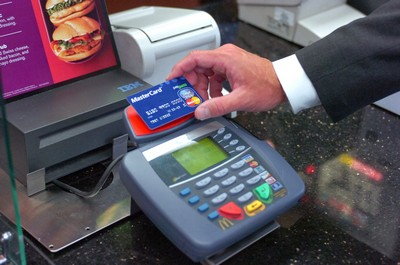
You are worried about this happening, right?
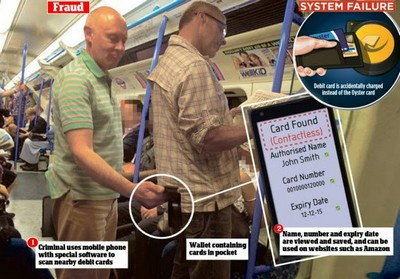
You don't have to worry. EMV is a chip standard that can have both contact and contactless interfaces. With the traditional contact interface, this means you actually have to physically insert the chip into a POS terminal for it to be authorized, like this:
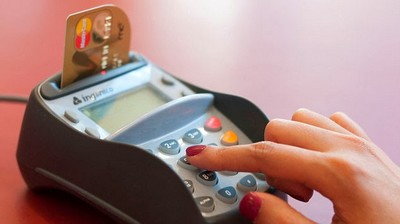
With the contact interface, nothing is wireless. No data is sent out in a stand-alone contact type EMV chip. With the EMV contactless interface, data is sent wirelessly.
Furthermore, contactless chip cards are required to show a symbol (looks like Wi-Fi symbol) somewhere on the card that to denote it's capability as a contactless card. For example, here's an example of a Discover Card with contactless capability (in which Discover calls "Discover ZIP") showing the contactless symbol on the back of the card:
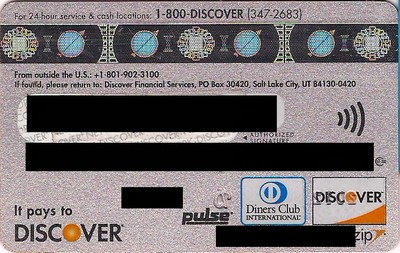
Don't believe everything that the media says. Besides, millions of people all over the world from London to Singapore, uses contactless payments daily in extremely crowded subways and mass transit with nary any problems. There are multiple layers of encrypted securities and keys that are needed to break the code.
Frankly, giving your physical card to a waiter/waitress who takes the card out of your view is much more susceptible to fraud than contactless payments.
Why should I care?
If you are an international traveler, you will want this because majority of the world has or in the process of converting to this payment format.
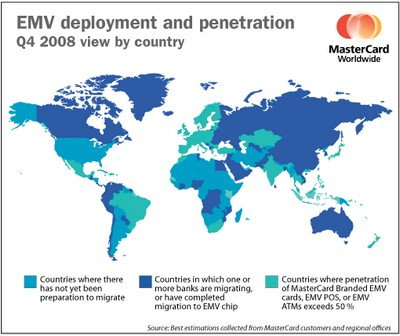
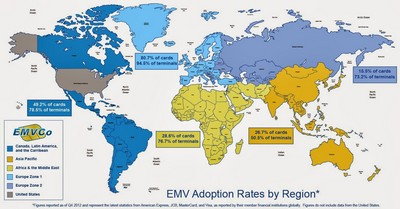
In fact, in 2012, even North Korea moved to the EMV format, leaving the US as one of the countries in the world that hasn't done so.
In addition, VISA, MC, AMEX, and Discover have all agreed to incentivize the USA shifting to EMV payments by 2015 by shifting liability for fraudulent transactions to merchants if they do not have EMV equipment and the cardholder has an EMV card. So if you travel internationally or would like to get one before the others, you might be interested in getting one.
BS! I had no problems using my card in [insert whereever country], [insert whatever point in time]
If you stick to the tourist path where they have lots of visitors from the US, you should have no problems using your mag-stripe only card in hotels and restaurants, at least for now. But as things can change as things go forward.
However, consider that once you start taking the off-beaten path, go to non-touristy places where they are not familiar with mag-stripes, rent a car and use toll roads, fill up gas, or try to buy train tickets you might end up into a trouble of the machine not recognizing your card because it lacks the chip. Furthermore, a lot of toll roads, gas pumps, and automated ticket machines lack any human assistance to help you when you need it the most.
But [insert credit card company] told me all merchants that display their logo must accept them! All I have to do is report them for violating their agreements, right?
There are several factors against this.
1. You can only speak English. The merchant representative, most likely a part-time clerk earning minimum wage, speaks in a different language, let's say French. If you have no French language skills, how are you going to get your point across? Are you going to whip out your cell phone at exorbitant int'l roaming charges and hope the customer service is going to translate it for you on the spot? Or maybe you might actually know French. But how about Swahili, Farsi, Balinese, or the multiple languages in mainland China?
2. Just like US, the rest of the world's businesses uses part-time minimum wage workers as cashiers to cut down on labor costs. Most of their SOP training manuals are written by MBA types to not to do anything they are not familiar with. Do not expect them to understand the intricate details of credit card mumbo jumbo. You don't expect Taco Bell employees to understand the minute details of Discover-JCB-Union Pay agreements, right? Same thing the other way around: be respectful as a guest in their country, prepare in advance in their ways, avoid being an "ugly American" stereotype.
3. You are a guest in their country. You are a minority. If 99.9% of their country's people and other tourists from around the world uses EMV, do you really think they are going to accomodate the 0.1% of American tourists who only have mag-stripes credit cards?
4. Again, you are a guest in their country. How would you, as an American standing in line, react if a Chinese tourist was clogging up the lines at a local Taco Bell because the clerk doesn't understand the Discover-Union Pay agreement and has trouble communicating between Mandarin spoken by the tourist and English spoken by the Taco Bell clerk? Same way the other way around. You do not want to clog up the lines for everyone. The less hassle, the better.
5. VISA and MC make tons of money from merchants in that country. Say SNCF French Rail. It's a billion dollar company in France. Do you think VISA is going to pull the plug of their relationship with SNCF because SNCF refuses to do mag-stripe processing at their unmanned train station kiosk? Of course not. Be realistic.
6. And lastly, if you're up against an unstaffed toll kiosk, gas pump or train ticket machine, are you going to yell curses at the machine?
But I want my credit card to be able to be used in the US too!
No worries. They have not gotten rid of the mag-stripe on the back of the card for backward compatibility reasons, just like we still have embossed numbers on our cards for backwards compatibility to using those old carbon copy imprinters.
[insert own Hyatt card image front and back together with red arrows pointing to all the backward compatibility features]
You use the chip on the front of the card abroad (for now), and the mag-stripe just like any other card for the US. Basically, you're increasing your credit card's acceptance rate by getting a card that both via the chip and the mag-stripe. You're getting a better deal for free.
And when 2015 comes along and US switches to EMV, you'll be way ahead of everyone else too!
So why did the rest of the world and the US moved/moving toward EMV?
Primarily, due to fraud concerns. You see, the mag-stripe has been with us since the 1950s. It may have been the most high tech thing back in the day, but with the technology that is available today, any shmo can pick up a $100 USB magnetic card skimming device off of eBay and get your credit card info.
And unlike skimming off contactless cards which actually need the person to have l33t programming skills, skimming off a magnetic stripe has become so ubiquitous that nary a day goes about skimming fraud going on somewhere in America, from gas pumps, Michael's stores (2011), Target breaches (2013), restaurant waiters/waitresses, to even McDonald's drive thrus.
https://www.google.com/search?q=skimming+fraud
These type of fraud used to be prevalent in Europe. But once they started switching over to EMV starting over 2 decades ago, this type of fraud went elsewhere. It went over to Asia, Canada and Mexico, Latin America, etc. etc. until they too began implementing EMV to combat skimming fraud. The US is practically the only country left that hasn't done so, therefore all the fraud that used to take place elsewhere is now happening here.
But EMV is old and it's not fool proof. Shouldn't we just skip over it and do something new instead?
Yes, EMV is old. It was developed in the 1990s and its smart card payment predecessor was first introduced in France. But as of today, it has become the defacto global standard of payments.
But then, what else is there? There is no other de facto global standard of payments alternative. For example, if we decide to skip over it and do something new, hypothetically like DNA matching technology, it still means US int'l travelers will continue to have problems abroad with useless plastic acceptance because no other country is using this DNA matching technology except the US.
Besides, nothing is fool proof. You can say that the bank vault isn't fool proof because you can crack it open if enough C4 is used. But your average low-life scumbag isn't likely to get military grade C4 easily either. But the bank vault does make it harder to get the bank's money over say a petty cash box. That's the point here. EMV is akin to a security tight bank vault, the old mag-stripe is akin to a petty cash box lying around inside the drawer.
I'm a business owner and I don't think EMV is going to take off. I'm not going to spend extra hundreds of dollars to upgrade my credit card machine. Convince me other wise why I should.
I can understand the added extra cost to your business once this switchover takes place. But before even saying that, look at your existing POS terminal. Does it have a slot somewhere to insert a card?
Most likely, if you had replaced your POS terminal within the past five years, you already have an EMV capable terminal. EMV is basically just not turned on yet from the processor and acquirer side.
If you have an EMV capable terminal, then a best bet would be to contact your acquirer to have the EMV feature turned on. You did your end of the deal already by having an EMV capable terminal, it is now the acquirers' responsibility to turn it on in accordance to the EMV switchover mandate.
And if you don't, you are going to replace your POS terminal anyway from common wear and tear. It isn't a hard switch-over. You can continue to use your POS terminal until it dies out because EMV cardholders will still have the mag-stripe on the back. And by the time your non-EMV capable POS terminal is up for replacement the market will be full with these newer POS terminals that can accept the mag-stripe, EMV, as well as contactless payments.
In addition, you may also want to check with your acquirer or processor about EMV capable terminals. Some of them are willing to replace your terminal for free in preparation for the US EMV switchover. Call and ask for details.
But what's in it for me? I'm the one that has to pay for the upgrade.
All the major card networks have given incentives for merchants for the upcoming EMV switchover.
If 75% or more of your credit card transactions are done on an EMV contact and contactless terminal, they are going to waive your annual PCI-DSS fees, which usually costs you around $5.00-$19.95/month per terminal. The overall long term cost savings of those compliance fees will be larger than the cost of an one time upgrade for the terminal.
The downside is that once EMV switchover happens and if you do not have a POS terminal that is able to accept EMV, the fraud liability shifts over to the merchant.
I own several fast food franchises. If I upgrade my POS terminals at all of my restaurants, it's going to cost me thousands, if not millions. I don't think anyone is going to use a fake credit card to buy $5 burgers. And if they do, wouldn't it be cheaper for me to eat the fraud cost?
Remember also that fraud isn't just committed by dishonest customers using fraudulent cards. Fraud can also happen with dishonest employees skimming off credit card data from the mag-stripe as in the case of a teenage McDonald's drive thru employee skimming off $13,000 of customers' credit cards in Olympia, WA. Consider the public relations fall out that your business may have if this happens (i.e. the big Target breach of 2013, where someone used a mag stripe card to load malware INTO Target's system). Is it worth risking to take such a huge PR disaster?
EMV wikipost volunteers: kebosabi
What is EMV?
EMV is a defacto global standard of technology where there is a visible microchip on the front of the card. It looks like this:

Who issues them?
See Google Docs spreadsheet in Post #1
SFOAMS also has created a list of excellent webpage that shows US EMV cards in a more interactive interface
Another site, which lets you narrow the search for an EMV card by various parameters, is http://www.spotterswiki.com/emv/index.php.
Several credit unions issue some form of Chip-and-PIN credit cards or prepaid cards. Prepaid EMV cards however are not recommended due to junk fees. USAA (currently restricted to members of military) used to offer Chip-and-PIN cards, but as late has backtracked to Chip-and-Signature priority.
Hey that's a cool Google Docs list! I know others that aren't on that list. How can I help by adding them to the list?
My bad for not putting this into the wiki sooner. Right now, the Google Docs is locked out of editing and only in "read-only" view because there were instances in the past where people would just delete the rows not thinking that it affects others viewing the list.
If you promise not to delete any rows and input all the pertinent info (annual fee, rewards, FTF, etc.), I can provide you with edit access. Just shoot me a PM to kebosabi with your gmail address and I'll provide you edit access.
Thanks for helping out!
As of October 2014, no USA-based card issuer offers Chip-and-PIN priority cards except for BMO Harris (Diners Club) and UN Federal Credit Union. Other major USA-based banks such as BofA, Chase, Citi, as well as others issue Chip-and-Signature cards which may work at many automated kiosks. However, bear in mind the word may is used above is a context where there is no absolute certainty of success for certain environments such as automated kiosks due to different natures of offline and online transactions. It is highly recommended to read Post #3 which lists real life FTer examples on how Chip-and-Signature worked and did not work at various transaction environments.
Can I upgrade it right now?
If it's listed on that Google Docs spreadsheet or SFOAMS' Silk page, wouldn't hurt to call/twitter them for a free upgrade. If you get the response you don't like, hang up, try again.
What is the difference between Chip-and-Signature and Chip-and-PIN?
You insert the chipped card into the slot. The physical contact terminal will read the EMV chip and the terminal will automatically read the preferred cardholder verification methods (called CVM) for that card.
Chip-and-Signature means that the terminal will printout a receipt for you to sign. This is the most prevalent authentication for most US issued EMV cards. Chip-and-Signature helps in a way that it will get through to face-to-face merchant transactions where you and the merchant do not speak the same language.
Chip-and-PIN means that the terminal will prompt you to input a PIN for authentication. Some credit union issued credit cards will have this CVM as secondary if Chip-and-Signature cannot be done. Chip-and-PIN is the more prevalent method of authentication used outside the US, especially in transaction environments where no human interaction is needed (i.e. automated gas pumps, toll roads, train kiosks, etc.).
The Google Docs spreadsheet will list which CVM are used in the EMV cards listed. Some cards can only do Chip-and-Signature. Other cards can do both Chip-and-Signature and Chip-and-PIN. And others might have a third option called No CVM (no authentication needed) which is reserved for low value transactions.
One chip can hold a lot more data, therefore it is capable of doing multiple verification methods. That's one of the great things about EMV over the mag-stripe which can hold very little data.
I want to know for sure what my EMV chip does. Is there anyway I can test out my own EMV card to see what the CVM list is?
alexmt has written up a nice step-by-step procedure on Post #3615.
If most of the EMV cards in the US is the Chip-and-Signature type, doesn't that mean it's still useless abroad?
Depends if you see it as glass half empty or glass half full. See Post #3 for further details on how Chip-and-Signature has worked both successfully and unsuccessfully depending on the merchant transaction environment and use your best judgment whether which one is right for you.
Are there any places in the US that are accepting transactions via the EMV chip?
tmiw has created a dedicated Google maps webpage to show where EMV has been proven to work here: http://emvacceptedhere.com/ Per his Post #4240, feel free to add any places with active EMV terminals if you come across one.
As of 2014/05, the EMV terminals in most Walmarts and Sam's Clubs are being turned on. Hence, the best place to try them out would be your local Walmart or Sam's Club. For other merchants, it's slowly being phased in.
I hope people will post them in the Post your receipt of your 1st EMV based transaction in the US thread. cvarming has shown us an EMV transaction receipt from Brooklyn, NY in Post #2380. I myself had my first EMV based (Chip-and-Signature) transaction in two stores in the Los Angeles area, as shown in detail in Post #2705 (courtesy of WhatWhatTech for pointing these two stores out)
I don't want a chip in my card. I heard horror stories all over the media saying hackers can steal my credit card info from a mile away.
There are two types of chips. One is contactless and the other is contact. Cards can be either one or the other, or both.
In the Google Docs spreadsheet, the cards that are capable of contactless payments are listed seperately under the "RFID or NFC contactless chip" column. If it says yes, then that means it has the ability to do contactless payments. If it says no, it doesn't have that feature.
The one that the media has overhyped about hackers "stealing your information wirelessly" was the contactless type like this:

You are worried about this happening, right?

You don't have to worry. EMV is a chip standard that can have both contact and contactless interfaces. With the traditional contact interface, this means you actually have to physically insert the chip into a POS terminal for it to be authorized, like this:

With the contact interface, nothing is wireless. No data is sent out in a stand-alone contact type EMV chip. With the EMV contactless interface, data is sent wirelessly.
Furthermore, contactless chip cards are required to show a symbol (looks like Wi-Fi symbol) somewhere on the card that to denote it's capability as a contactless card. For example, here's an example of a Discover Card with contactless capability (in which Discover calls "Discover ZIP") showing the contactless symbol on the back of the card:

Don't believe everything that the media says. Besides, millions of people all over the world from London to Singapore, uses contactless payments daily in extremely crowded subways and mass transit with nary any problems. There are multiple layers of encrypted securities and keys that are needed to break the code.
Frankly, giving your physical card to a waiter/waitress who takes the card out of your view is much more susceptible to fraud than contactless payments.
Why should I care?
If you are an international traveler, you will want this because majority of the world has or in the process of converting to this payment format.


In fact, in 2012, even North Korea moved to the EMV format, leaving the US as one of the countries in the world that hasn't done so.
In addition, VISA, MC, AMEX, and Discover have all agreed to incentivize the USA shifting to EMV payments by 2015 by shifting liability for fraudulent transactions to merchants if they do not have EMV equipment and the cardholder has an EMV card. So if you travel internationally or would like to get one before the others, you might be interested in getting one.
BS! I had no problems using my card in [insert whereever country], [insert whatever point in time]
If you stick to the tourist path where they have lots of visitors from the US, you should have no problems using your mag-stripe only card in hotels and restaurants, at least for now. But as things can change as things go forward.
However, consider that once you start taking the off-beaten path, go to non-touristy places where they are not familiar with mag-stripes, rent a car and use toll roads, fill up gas, or try to buy train tickets you might end up into a trouble of the machine not recognizing your card because it lacks the chip. Furthermore, a lot of toll roads, gas pumps, and automated ticket machines lack any human assistance to help you when you need it the most.
But [insert credit card company] told me all merchants that display their logo must accept them! All I have to do is report them for violating their agreements, right?
There are several factors against this.
1. You can only speak English. The merchant representative, most likely a part-time clerk earning minimum wage, speaks in a different language, let's say French. If you have no French language skills, how are you going to get your point across? Are you going to whip out your cell phone at exorbitant int'l roaming charges and hope the customer service is going to translate it for you on the spot? Or maybe you might actually know French. But how about Swahili, Farsi, Balinese, or the multiple languages in mainland China?
2. Just like US, the rest of the world's businesses uses part-time minimum wage workers as cashiers to cut down on labor costs. Most of their SOP training manuals are written by MBA types to not to do anything they are not familiar with. Do not expect them to understand the intricate details of credit card mumbo jumbo. You don't expect Taco Bell employees to understand the minute details of Discover-JCB-Union Pay agreements, right? Same thing the other way around: be respectful as a guest in their country, prepare in advance in their ways, avoid being an "ugly American" stereotype.
3. You are a guest in their country. You are a minority. If 99.9% of their country's people and other tourists from around the world uses EMV, do you really think they are going to accomodate the 0.1% of American tourists who only have mag-stripes credit cards?
4. Again, you are a guest in their country. How would you, as an American standing in line, react if a Chinese tourist was clogging up the lines at a local Taco Bell because the clerk doesn't understand the Discover-Union Pay agreement and has trouble communicating between Mandarin spoken by the tourist and English spoken by the Taco Bell clerk? Same way the other way around. You do not want to clog up the lines for everyone. The less hassle, the better.
5. VISA and MC make tons of money from merchants in that country. Say SNCF French Rail. It's a billion dollar company in France. Do you think VISA is going to pull the plug of their relationship with SNCF because SNCF refuses to do mag-stripe processing at their unmanned train station kiosk? Of course not. Be realistic.
6. And lastly, if you're up against an unstaffed toll kiosk, gas pump or train ticket machine, are you going to yell curses at the machine?
But I want my credit card to be able to be used in the US too!
No worries. They have not gotten rid of the mag-stripe on the back of the card for backward compatibility reasons, just like we still have embossed numbers on our cards for backwards compatibility to using those old carbon copy imprinters.
[insert own Hyatt card image front and back together with red arrows pointing to all the backward compatibility features]
You use the chip on the front of the card abroad (for now), and the mag-stripe just like any other card for the US. Basically, you're increasing your credit card's acceptance rate by getting a card that both via the chip and the mag-stripe. You're getting a better deal for free.
And when 2015 comes along and US switches to EMV, you'll be way ahead of everyone else too!
So why did the rest of the world and the US moved/moving toward EMV?
Primarily, due to fraud concerns. You see, the mag-stripe has been with us since the 1950s. It may have been the most high tech thing back in the day, but with the technology that is available today, any shmo can pick up a $100 USB magnetic card skimming device off of eBay and get your credit card info.
And unlike skimming off contactless cards which actually need the person to have l33t programming skills, skimming off a magnetic stripe has become so ubiquitous that nary a day goes about skimming fraud going on somewhere in America, from gas pumps, Michael's stores (2011), Target breaches (2013), restaurant waiters/waitresses, to even McDonald's drive thrus.
https://www.google.com/search?q=skimming+fraud
These type of fraud used to be prevalent in Europe. But once they started switching over to EMV starting over 2 decades ago, this type of fraud went elsewhere. It went over to Asia, Canada and Mexico, Latin America, etc. etc. until they too began implementing EMV to combat skimming fraud. The US is practically the only country left that hasn't done so, therefore all the fraud that used to take place elsewhere is now happening here.
But EMV is old and it's not fool proof. Shouldn't we just skip over it and do something new instead?
Yes, EMV is old. It was developed in the 1990s and its smart card payment predecessor was first introduced in France. But as of today, it has become the defacto global standard of payments.
But then, what else is there? There is no other de facto global standard of payments alternative. For example, if we decide to skip over it and do something new, hypothetically like DNA matching technology, it still means US int'l travelers will continue to have problems abroad with useless plastic acceptance because no other country is using this DNA matching technology except the US.
Besides, nothing is fool proof. You can say that the bank vault isn't fool proof because you can crack it open if enough C4 is used. But your average low-life scumbag isn't likely to get military grade C4 easily either. But the bank vault does make it harder to get the bank's money over say a petty cash box. That's the point here. EMV is akin to a security tight bank vault, the old mag-stripe is akin to a petty cash box lying around inside the drawer.
I'm a business owner and I don't think EMV is going to take off. I'm not going to spend extra hundreds of dollars to upgrade my credit card machine. Convince me other wise why I should.
I can understand the added extra cost to your business once this switchover takes place. But before even saying that, look at your existing POS terminal. Does it have a slot somewhere to insert a card?
Most likely, if you had replaced your POS terminal within the past five years, you already have an EMV capable terminal. EMV is basically just not turned on yet from the processor and acquirer side.
If you have an EMV capable terminal, then a best bet would be to contact your acquirer to have the EMV feature turned on. You did your end of the deal already by having an EMV capable terminal, it is now the acquirers' responsibility to turn it on in accordance to the EMV switchover mandate.
And if you don't, you are going to replace your POS terminal anyway from common wear and tear. It isn't a hard switch-over. You can continue to use your POS terminal until it dies out because EMV cardholders will still have the mag-stripe on the back. And by the time your non-EMV capable POS terminal is up for replacement the market will be full with these newer POS terminals that can accept the mag-stripe, EMV, as well as contactless payments.
In addition, you may also want to check with your acquirer or processor about EMV capable terminals. Some of them are willing to replace your terminal for free in preparation for the US EMV switchover. Call and ask for details.
But what's in it for me? I'm the one that has to pay for the upgrade.
All the major card networks have given incentives for merchants for the upcoming EMV switchover.
If 75% or more of your credit card transactions are done on an EMV contact and contactless terminal, they are going to waive your annual PCI-DSS fees, which usually costs you around $5.00-$19.95/month per terminal. The overall long term cost savings of those compliance fees will be larger than the cost of an one time upgrade for the terminal.
The downside is that once EMV switchover happens and if you do not have a POS terminal that is able to accept EMV, the fraud liability shifts over to the merchant.
I own several fast food franchises. If I upgrade my POS terminals at all of my restaurants, it's going to cost me thousands, if not millions. I don't think anyone is going to use a fake credit card to buy $5 burgers. And if they do, wouldn't it be cheaper for me to eat the fraud cost?
Remember also that fraud isn't just committed by dishonest customers using fraudulent cards. Fraud can also happen with dishonest employees skimming off credit card data from the mag-stripe as in the case of a teenage McDonald's drive thru employee skimming off $13,000 of customers' credit cards in Olympia, WA. Consider the public relations fall out that your business may have if this happens (i.e. the big Target breach of 2013, where someone used a mag stripe card to load malware INTO Target's system). Is it worth risking to take such a huge PR disaster?
USA EMV cards: Availability, Q&A (Chip & PIN -or- Chip & Signature) [2012-2015]
#3016
Join Date: Jan 2005
Programs: UA GOLD MM,WN CP A+list, HH Gold,MR LT Titanium
Posts: 2,184
Surprised at how many things this post from the Wall Street Journal got wrong!
http://blogs.wsj.com/corporate-intel..._sections_tech
http://blogs.wsj.com/corporate-intel..._sections_tech

#3017
Join Date: Jul 2006
Location: LAX
Programs: AA EXP 1.5MM, Asiana Club Silver, KE Morning Calm, Hyatt Platinum, Amtrak Select
Posts: 7,161
That's why I've pretty much given up on all major news publications and news reporting and instead, rely on searching topics on Google. Google search results are able to give me a broader perspective of what's happening instead of just having a narrowed-view information being fed to me.
#3018
Join Date: Jan 2005
Programs: UA GOLD MM,WN CP A+list, HH Gold,MR LT Titanium
Posts: 2,184
While my industry relies heavily on the continued implementation of these technologies now, I personally did not embrace it-to the extent of using an RFID wallet.
While there have been great strides made in the security and implementation of EMV, NFC and such, I believe it may be a tough sell to the general public.
Conflicting opinions on timelines and methods still exist-as evidenced in SLC this week.
#3019
Join Date: Jul 2006
Location: LAX
Programs: AA EXP 1.5MM, Asiana Club Silver, KE Morning Calm, Hyatt Platinum, Amtrak Select
Posts: 7,161
I profoundly remain optimistic that contactless would take off. It is practically the norm elsewhere outside the US, there are no problems with them, so any talk about "hackers stealing info from a mile away" or concerns like the photos on the wiki, are at least to me, akin to being too paranoid with tin-foil hat conspiracies.
#3020
Join Date: Feb 2013
Posts: 401
I profoundly remain optimistic that contactless would take off. It is practically the norm elsewhere outside the US, there are no problems with them, so any talk about "hackers stealing info from a mile away" or concerns like the photos on the wiki, are at least to me, akin to being too paranoid with tin-foil hat conspiracies.
#3021
Join Date: Jul 2012
Location: Canada
Programs: BA Gold (OWE), Star Alliance Gold, Hilton Diamond
Posts: 2,194
In countries like the UK,Poland, Australia and NZ, contactless has pretty much become the "norm" or at least every knows what it is. For example, http://www.lloydsbank.com/credit-car...os-rewards.asp doesn't even mention their cards being contactless anymore (The pictures is the only indication), its just considered something that comes as standard. Also Transport for London has also enabled contactless payments on all London transport for many trialists (The majority of existing Oyster pay as you go holders are eligible for it) and it should be enabled for everyone by the end of March. http://www.youtube.com/watch?v=uwHeaZJQm3k Shows the system. This is bound to get people paying contactless even more (And not just on the tube, but in shops as well).
Last edited by reclusive46; Feb 7, 2014 at 5:26 pm
#3022
FlyerTalk Evangelist
Join Date: Dec 2002
Location: Danville, CA, USA;
Programs: UA 1MM, WN CP, Marriott LT Plat, Hilton Gold, IC Plat
Posts: 15,721
So for those who don't read every thread, basically there are no major US-banks that will issue chip +PIN cards except for Wells Fargo. And I refuse to pay 3% forex just to have a PIN - I'll take my chances with the no forex Chase chip+sig cards.
Chase does not issue chip+PIN cards - your British Air card is chip + Signature. Glad to hear that it worked.
I went to Paris, France for a week, and not only was I able to use my non EMV credit card at the Monop grocery store and several restaurants, but my EMV chip + signature issued Bank of America credit card and my Chase British Airways chip+ pin card worked to acquire subway tickets at the unmanned kiosk at both the Gare de Lyon station as well as other stations throughout the paris metro.
#3023
Join Date: Jul 2006
Location: LAX
Programs: AA EXP 1.5MM, Asiana Club Silver, KE Morning Calm, Hyatt Platinum, Amtrak Select
Posts: 7,161
There are contactless debit and credit cards, even proprietary cards are widely used in Japan, South Korea, Taiwan, Hong Kong and Singapore. Many banks offer contactless payment cards.
i.e.:
Singapore DBS Bank Live Fresh Card: http://www.dbs.com.sg/personal/cards...h/default.page
Hong Kong Hang Seng Bank enJoy card: http://bank.hangseng.com/1/2/persona...ded/enjoy-card
Japan Orico UPty Paypass: http://www.orico.co.jp/creditcard/uptypaypass/
etc. etc...
Even their contactless transit cards are defacto reloadable contactless cards because they have the ability to purchase more things than just riding their transit system. One can use HK's Octopus Card to ride HKMTR as well as buy goods and services at shops all over town. The same with T-Money in Korea, Suica/PASMO in Japan, Easy Card in Taiwan and the EZ-Link in Singapore. It may not be a VISA or a MC, but in effect, it's the same thing as a reloadable debit card because you can actually buy more things with it than using it for transit.
I take it that where there is high use of mass transit, introduction of contactless cards tends to be easier because it's easier to "phase in" to the masses' mindset because they're already used to the tap-n-go to ride concept as they use the mass transit system. And no, I have not heard any single report of hackers snooping around the crowded subways in Tokyo, Seoul, Taipei, Hong Kong, or Singapore and stealing info wirelessly from transit riders there either.
Over here, outside the NE, most people tend to drive than use mass transit. And for the most part, they all tend to use flat rate fares which doesn't require the use of contactless cards for a variable rate fare system; just a single payment per boarding (you pay the same amount whether you take transit for a 1 mile or 10 miles) or show a unlimited ride monthly pass.
Hence the idea of "why do I need contactless payments in the first place" tends to be the average mindset for most Americans. Majority of Americans don't ride the bus or rail system on a daily basis as Europeans or Asians do. And even if they do, they tend to be flat rate fares or show a monthly pass instead of a "ride through the system, tapping in and tapping out, deduct fares automatically based on zones or distance" system as widely used in Europe or Asia.
The closest thing I see in use is Chicago's new Ventra Card where an all-in-one contactless debit MC has the ability to pay for CTA and PACE rides and purchase goods and services using the debit MC portion, the SmarTrip used in the DC Metro, or the BART ClipperCard used in San Francisco. That's pretty much it.
Last edited by kebosabi; Feb 7, 2014 at 7:31 pm
#3024
Join Date: Apr 2007
Location: SEA
Programs: AS MVP, Hhonors Gold, National Executive, Identity Gold, MLife Gold
Posts: 2,687
This is without a doubt the best way to get incorrect information on a wide variety of topics.
#3025
Join Date: Jul 2006
Location: LAX
Programs: AA EXP 1.5MM, Asiana Club Silver, KE Morning Calm, Hyatt Platinum, Amtrak Select
Posts: 7,161
How do you think I got the notion that people were scared about "chips being in cards" and decided that it was worthwhile to note that onto the wiki? Because Google searches lead me to past comments sections in various news articles that related to EMV, and in them they always had several people making that "oh noes the gubbmint is tracking me" or "they can steal your info wireless from a mile away" comments all the time.
You get double the amount of info and opinions if you can Google in different languages too and be able to see things from a different perspective as well.
IMO, spoon-fed journalism is dead. If you can utilize Google on it's capabilities and know how to do research, and the additional benefit of being able to Google in a different language, the amount of knowledge you get is enormous.
Besides, who doesn't use Google these days. This thread is a perfect example. There were no thread or list or discussion board that extensively discussed EMV a few years ago. Now this thread ranks high up in Google's Page Rank when one searches the term "EMV cards USA." This thread and the Google Docs spreadsheet link is all over travel, credit card, and miles/points hounding websites like milepoint, Frommers, myficoforums, frugal travel guy, million mile secrets, etc. etc.
If anyone is interested about EMV, they can Google the search terms and it leads them to this thread. I even get e-mails from people working at regional banks saying they want to share my Google Docs info because they stumbled upon here using Google!
IMO, that's going to be the way real news, data, and public opinion will be gathered in the future - from Google searches. If there are no good topics or even correct ones, the best way to do it is to create one of your own and hopefully, gather enough posts, comments, supporters, haters, antis, opinions, rebuttals, discussions and debates so that it becomes high on Google's Page Rank system.
Last edited by kebosabi; Feb 8, 2014 at 12:45 am
#3026
Moderator: Manufactured Spending
Join Date: Jul 2011
Posts: 6,580
You get double the amount of info and opinions if you can Google in different languages too and be able to see things from a different perspective as well.
IMO, spoon-fed journalism is dead. If you can utilize Google on it's capabilities and know how to do research, and the additional benefit of being able to Google in a different language, the amount of knowledge you get is enormous.
Besides, who doesn't use Google these days. This thread is a perfect example. There were no thread or list or discussion board that extensively discussed EMV a few years ago. Now this thread ranks high up in Google's Page Rank when one searches the term "EMV cards USA." This thread and the Google Docs spreadsheet link is all over travel, credit card, and miles/points hounding websites like milepoint, Frommers, myficoforums, frugal travel guy, million mile secrets, etc. etc.
IMO, spoon-fed journalism is dead. If you can utilize Google on it's capabilities and know how to do research, and the additional benefit of being able to Google in a different language, the amount of knowledge you get is enormous.
Besides, who doesn't use Google these days. This thread is a perfect example. There were no thread or list or discussion board that extensively discussed EMV a few years ago. Now this thread ranks high up in Google's Page Rank when one searches the term "EMV cards USA." This thread and the Google Docs spreadsheet link is all over travel, credit card, and miles/points hounding websites like milepoint, Frommers, myficoforums, frugal travel guy, million mile secrets, etc. etc.
If you are doing research on a topic you know nothing about, do you trust discussion boards? I certainly hope not. You can definitely read them to get a feel for the topic, but you should never rely on any information you find that way without verifying it yourself.
#3027
Join Date: Jul 2009
Location: KWI
Programs: AA EXP
Posts: 806
So for those who don't read every thread, basically there are no major US-banks that will issue chip +PIN cards except for Wells Fargo. And I refuse to pay 3% forex just to have a PIN - I'll take my chances with the no forex Chase chip+sig cards.
Chase does not issue chip+PIN cards - your British Air card is chip + Signature. Glad to hear that it worked.
I went to Paris, France for a week, and not only was I able to use my non EMV credit card at the Monop grocery store and several restaurants, but my EMV chip + signature issued Bank of America credit card and my Chase British Airways chip+ pin card worked to acquire subway tickets at the unmanned kiosk at both the Gare de Lyon station as well as other stations throughout the paris metro.
#3028
Join Date: Jan 2014
Location: Cambridge, MA, US
Programs: Hyatt, Amtrak
Posts: 26
The closest thing I see in use is Chicago's new Ventra Card where an all-in-one contactless debit MC has the ability to pay for CTA and PACE rides and purchase goods and services using the debit MC portion, the SmarTrip used in the DC Metro, or the BART ClipperCard used in San Francisco. That's pretty much it.
It'll be interesting to see what happens with the commuter rail system (zoned-based pricing) which is contracted-out--the last decade to a consortium of Veolia (a French company) and Bombardier, who just a few weeks ago was outbid by another French company (Keolis) which is actually owned by none other than SNCF... (which raised a few eyebrows in the French business press regarding fairness, given that they have gov't backing).
Last edited by blue2000; Feb 8, 2014 at 2:26 am
#3029
FlyerTalk Evangelist
Join Date: Jan 2014
Location: San Diego, CA
Programs: GE, Marriott Platinum
Posts: 15,507
Heh, apparently BoA won't tell you your cash advance PIN over the phone, only via US mail. Too bad I'll be back in the US by then. (At least if I find a place that accepts EMV there I can try it, right?)
#3030
Join Date: Mar 2012
Location: Miami BCH., FLorida
Programs: AA:EXP, GLD:A.Argen., Etihad; Turk SIL:UA, VS; HOT.GLD:ClubC, Loews, SPG; PL:Ritz, Hil, IHG, BtW., R
Posts: 261
I looked in depth at the spreadsheet, and would
May I suggest that we create a sticky in the 1st post with a running list of cards where users may request a chip and pin card? I have been skimming this thread and see the two cards noted above and also the Chase BA card. The sticky on the best credit card offers over in MilesBuzz has been extremely useful to FTers, and I can see a running list of chip/pin-capable cards becoming a handy reference, too.
Moderator edit: kebosabi has responded to this suggestion by creating an editable Google worksheet which summarizes the EMV cards available from USA-issuers today:
https://docs.google.com/spreadsheet/...k01SHZvTUMxdUE
Moderator edit: kebosabi has responded to this suggestion by creating an editable Google worksheet which summarizes the EMV cards available from USA-issuers today:
https://docs.google.com/spreadsheet/...k01SHZvTUMxdUE



